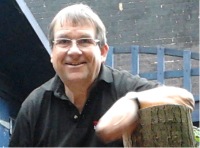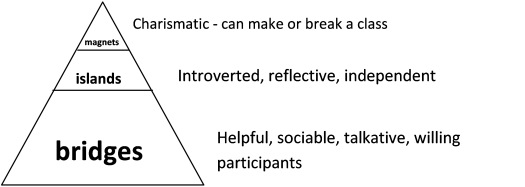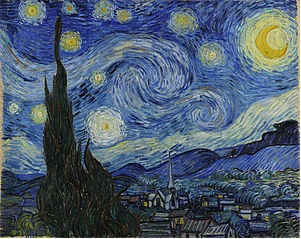Creative Thinking
Peter Clements, UK
Peter Clements teaches EFL and Academic English in a well renowned local organization in Canterbury, Kent in the UK. This work involves preparing students for IELTS exams as well as supporting them in their in their mainstream academic studies. These are mainly young people aiming to enter UK universities. He formerly taught ESOL in Adult and Community Learning with mature adult students and those of the migrant community. E-mail: peter.clements@talktalk.net

Menu
Introduction
Assumptions - on what do we base them?
Bridges, islands and magnets
I see, I think, I wonder
References
As a lead in to this lesson, we were faced with a word puzzle on the whiteboard. I won’t spoil things by saying what it was but it looked very difficult at face value until you realized that the answer was staring you in the face. It required stripping the requirements of the question to the basic elements and doing literally what the wording of the question required rather than what it implied. It reminded me of the kind of thinking required to solve cryptic crosswords that are so popular in Britain.
Here’s an example: ‘In September, links will be made with this city (6 letters) ’. To solve this clue, you realise that the answer is the name of a city. The mind might go along the path of thinking what is happening in September, maybe some event or other, but all of this is irrelevant. The answer is found in the last three letters of September and the first three of links, answer, BERLIN. It was this kind of thinking that was required to solve the puzzle in front of us which seemed impossible at first but then simple when you found the answer.
Bonnie then issued the class with a number of different pictures, one per pair of participants. We were required to note down four things we assumed about the person in the picture. These would be determined by features such as expression, pose, clothing, surroundings and so forth.
Now to illustrate this, I am going to refer back to the picture above at the end of the review of Marian’s workshop because I took this photo myself after having been fooled by some assumptions I made.
I was cycling one day up to London and was approaching the military barracks at Woolwich Arsenal. A wide expanse opened up ahead of me, evidently a parade ground. This assumption was confirmed by the neat rows of what I assumed to be soldiers standing to attention. I anticipated hearing the shout of a command at any moment and the men would begin to march or change position. But as I approached the figures were still stationary which puzzled me, and it was only when I got closer that I realized they were made of iron - they were in fact sculptures!
The experience was actually quite unnerving; I had interpreted the evidence available and been misled into making a wrong assumption.
Going back to the workshop, after discussing our pictures and recording our assumptions, we then had to justify why we had made them - could they actually be verified or were they leaps of the imagination? The language potential here is immense - going beyond the obvious ‘what can you see?’ type activity but ‘why having to rationalize as to why you think you can see it!
There were naturally quite a few surprises when Bonnie revealed the circumstances of some of the pictures and some of found we were way off beam in our original assumptions.
Another point Bonnie made was that when visiting a gallery, people spend, on average, only a matter of seconds glancing at works of art; very few really take the time to look in detail. How long had we spent examining our pictures? We really had looked thoroughly and it was so enriching and generated so much speculation and debate.
At this stage, we were asked to engage in some free association about the properties of bridges, magnets and islands. The diversity of responses revealed positive and negative characteristics of each (in the case of magnets this was quite literal!). Bonnie then implied that there are bridges, islands and magnets in every language class. We discussed how the characteristics from the free association stage translated into learner qualities and how the dynamics of the classroom might be influenced. For example, magnets can either attract or repel. Attraction is a good thing surely? Well, not if the attention attracted by some students creates an imbalance or disturbance in class. Be sure to keep any magnets ‘on side’ let them work for you not against you! A teacher can use the occasional magnets wisely to the benefit of the class providing there are a good number of ‘bridges’ who will help facilitate connections by participating willingly in pair and group activities. A few ‘islands’ will also be an asset - these are the reflectors, the good listeners; self sufficient and perhaps introverted but in a positive way.
Here’s my interpretation of the make up of an ideal class as a result of this discussion:

Bonnie showed one way a teacher can use these characteristics in anticipating their influence in a typical timed activity in class. Being so willing, the ‘bridges’ are likely to go off task more quickly. Too many ‘islands’ working together will tend to be too quiet. ‘Magnets’ might attract their own ‘pet’ followers at the group formation stage. Being aware of the class make up in these terms is clearly very helpful and can be applied when assigning students to sub groups or when initiating discussion groups and suchlike.
This was a great activity. We were issued with another picture - it looked familiar as it was a Van Gogh scene but copied on ordinary A4 paper in black and white which did not do the original justice. And here was the point. The monochrome version obscured certain details which made the picture harder to interpret as the artist would have wanted. So we were faced with having to fill in areas by thinking creatively. There was village in a valley. Something stood blackened in the foreground - had it been burnt? Had there been a fire in the village? Was the village inhabited? There seemed to be swirling smoke or flames in the sky. Was the fire still raging?
All these speculations could be placed under the three headings of I see, I think, I wonder
and placed appropriately. Comments became even more diverse as we brainstormed. ‘ I wonder if the artist was happy with the picture?’ ‘I wonder if there’s a storm approaching?’ I wonder if people understand the picture?’ I wonder if those are flames going up into the sky?’ I wonder if the people in the village have left?’ Again - how long did we study this picture because we were intrigued by the possibilities? Can we similarly activate the creative thinking of our learners rather and go beyond the cursory glance and simple statements of the obvious that initially appears to the eye? Why yes! Bonnie related an experience of how a particular student had been so moved by thinking about this same picture that it had been a turning point in his experience of learning English.
There was an atmosphere of anticipation in class as Bonnie prepared to show us the original colour version of Van Gogh’s ‘Starry Night’ and as a music video of Don McLean’s ‘Vincent’ began to play over a backdrop of Van Gogh’s colourful works each coming into view,with the lyrics coming up on the screen superimposed over the beautifully poignant paintings. As this happened, a number of voices could be heard in the classroom singing along and I suspect there were a number of moist eyes as well.

‘Starry, starry night.
Paint your palette blue and grey,
Look out on a summer's day,
With eyes that know the darkness in my soul.
Shadows on the hills,
Sketch the trees and the daffodils,
Catch the breeze and the winter chills,
In colours on the snowy linen land.’
As I cycled home from Hilltop through the woods, it was indeed a starry night above the darkened pine trees and my heart swelled with joy. I was so glad to have shared in such an experience and to be a teacher and having the potential to make language learning a similarly joyful experience for my students.
Cranmer, David (1996) Bridges and Magnets in motivating high level learners, Pilgrims-Longman
Don McLean - Vincent ( Starry, Starry Night) With Lyrics available at:
www.youtube.com/watch?v=oxHnRfhDmrk&feature=related
How Long Does it Take To Look at a Painting?
www.huffingtonpost.com/james-elkins/how-long-does-it-take-to-_b_779946.html

Please check the Making Thinking Visible course at Pilgrims website.
Please check the Building Positive Group Dynamics course at Pilgrims website.


|